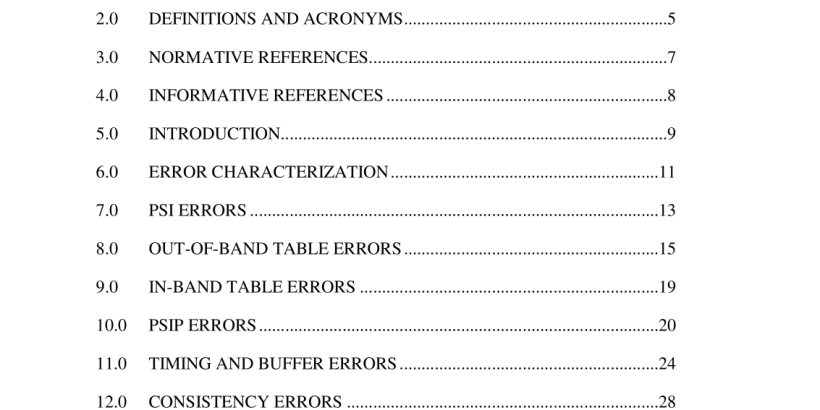ANSI SCTE 142-2017 pdf download.Recommended Practice for Transport Stream Verification
5.0 INTRODUCTION
The SCTE and ATSC standards define the contents and characteristics of the emission Transport Stream. There may be a large number of interactions and interrelationships amongst various components. Successful tuning and display of programs can be enabled if this Transport Stream adheres to the SCTE standards. The connection between the emission remultiplexer and the QAM modulator is the reference analysis point assumed in this document, as shown in Figure 1. Please note that this diagram shows only a conceptual, functional block view of a DTV system. In practice, actual implementations will only share MPEG data with other devices using the MPEG-2 Transport Stream (TS), as Elementary Streams (ES) or Packetized Elementary Streams (PES) cannot tolerate the introduction of any transmission errors and once synchronization is lost the system crashes. Furthermore, real systems may group the functions in different ways and will likely appear different on an electrical or physical block diagram. This Standard uses terms and acronyms defined in ISO 13818-1 [14], A/53-3 [5] and A/65 [6], and assumes a fair degree of familiarity with MPEG-2 systems as implemented per the SCTE standards. Readers that do not recognize the terms should read A/54A [17], A/69 [10], SCTE 54 [2], and SCTE 65 [3].
6.2 Discussion of Error Classification An explanation of the error classification scheme is as follows: 1. Transport Stream Off Air (TOA): The transport is effectively off-air as the Transport Stream errors are severe enough that transport level logical constructs are damaged beyond utility. Receivers will not be able to tune and decode anything within the transport. The complete or repeated absence of sync bytes would be an example of this level of error.
2. Program Off Air (POA): A main service (virtual channel) is flawed to the point that that service is effectively off air for conformant/reasonable receiver designs. This could involve all of the program elements being improperly constructed or incorrect/missing signaling about elements. The absence of a PMT instance for a service would be an example of this type of error.
3. Component missing (CM): One of the program components that is signaled by PSIP or PSI as present is either not present or cannot be found and decoded. One example would be a mismatch between the video PID signaled in the PMT and the actual PID used for the video elementary stream.
4. Quality of Service (QOS): Parameters are out of specification by such a margin that a significant fraction of the receivers can be expected to produce flawed outputs. In many cases, the broadcast is viewable, but may exhibit some form of degradation to the viewer. An example might be the PAT cycle time being somewhat longer than the specification, which would cause slower than normal tuning.
5. Technically Non-Conformant (TNC): Violates the letter of the standard, but in practice will have little effect on the viewing experience. Errors of this type should be corrected, but do not have the urgency of higher severity errors. An example might be a single instance of a 102 ms PAT cycle time (with the remainder of the PATs coming at less than 100 ms intervals).
7.0 PSI ERRORS
An SCTE transport stream is also required to be MPEG-2 conformant (see Section 5 in reference [15]). Therefore, an SCTE transport stream must include the two mandatory Program Specific Information (PSI) tables. These two tables are known as the Program Association Table (PAT) and the Program Map Table (PMT). The syntax is defined within ISO/IEC 13818-1 [14]. The maximum interval for the PAT is specified in the SCTE standards as 100 ms. The maximum interval for the PMT is specified in the SCTE standards as 400 ms. Exceeding the interval on each of these tables by a small amount should not have a major impact on a receiver, especially since each SCTE conformant receiver should be able to fully tune to any SCTE channel through the use of the SCTE SI tables.ANSI SCTE 142-2017 pdf download
